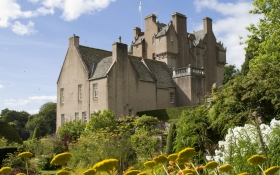
Scotland Sightseeing
- Scotland Northeast
- Scotland Southwest
- Scotland North
- Scotland East
- Scotland Central
- Scotland Centralwest
- View Courses of Scotland
< Crathes Castle & Gardens

< Aberdeen - Overview
< Aberdeen #1
< Aberdeen #2
< Aberdeen Old Town
< Bullars of Buchan
< Castle Fraser
< Fyvie Castle
< Pitmedden Gardens
< St Machar Cathedral
The castle, built in the second half of the 16th century, is a superb example of a tower house of the period. Some of the rooms retain their original painted ceilings and collections of family portraits and furniture. A visit is enhanced by the walled garden, which incorporates herbaceous borders and many unusual plants, providing a wonderful display at all times of the year.
Aberdeen, the Capital of the Grampian Highlands. Aberdeen is world-famous as the “Granite City” and the sun lit granite stone that is such a striking feature of numerous splendid buildings in its lively city centre. Aberdeen is a cathedral city with three cathedrals, the most impressive being St Machar’s, and is a regular winner of the “Britain in Bloom” trophy for it’s colourful floral displays and parks. Whether you are looking for great shopping, good food, culture, sport or a relaxing stroll in beautiful parks and gardens there is something for all tastes.
Visit Pitmedden Gardens to the north of Aberdeen. The centerpiece of this property is the Great Garden, originally laid out in 1675 by Sir Alexander Seton. Continue to Fyvie Castle. Lying between Aberdeen and Banff, the castle is beautifully situated on a mound above the River Ythan, Fyvie Castle is widely regarded as one of the most beautiful castles in Scotland and dates from the 13th century.
Take a tour of the Granite City of Aberdeen. Solid and confident, Aberdeen's foundations are in its University and its Port. The city presents a modern cosmopolitan image and many visitors are often surprised by the many diverse attractions, which this regional capital offers. Continue to Crathes Castle and Gardens. The tower house with its many turrets and gables provides a fairy tale quality, be sure to visit the award winning gardens, which were established in their present form in the 19th century.
Here is preserved the ancient dwellings and town plan of what was once a separate burgh. Don't miss King's College, the centre of Aberdeen University, an imposing four-square building erected around the famous Quadrangle. King's College Chapel, used for daily worship for five centuries, houses a collection of 15th century wood and ornamentation.
The Bullars of Buchan can be located off the A975 three miles north of Cruden Bay. It is a famous sea chasm some 200 feet deep where the ocean rushes in through a natural archway open to the sky. The cliff scenery here is some of the most spectacular in Britain.
This magnificent castle, one of the “Castles of Mar” dates from 1575 and incorporates earlier building. The castle comprises a wealth of historic furnishings, paintings and fine embroidery. The castle is surrounded by extensive parkland, walled garden, picnic area and woodland walks.
The five towers of Fyvie Castle enshrine five centuries of Scottish history, each being named after one of the five families that who owned the castle. The oldest part dates from the 13th century and is now probably the grandest example of Scottish Baronial architecture. Apart from the great wheel-stair, the finest in Scotland, there is an exceptionally important collection of portraits, arms and armour, and 16th century tapestries.
Originally laid out in 1675 by Sir Alexander Seton. Famous for it's displays using box hedges and bedding plants. The centrepiece of this property is the Great Garden, three of the formal parterres were taken from designs possibly used in the gardens at the Palace of Holyroodhouse, Edinburgh in 1647. The fourth parterre is a heraldic design based on Sir Alexander's coat-of-arms. In the 1950s re-creation of the elaborate floral designs was undertaken to give the gardens known today.
The cathedral was built in 1131 to replace St Machar's original Celtic church. Over the years St Machar's has been home to congregations of various Christian faiths. Until the 12th century Celtic, from 1131-1560 Roman Catholic, 1625-1638 and 1690-1685 Episcopalian, and from 1690 to the present Presbyterian. There are surely very few, if any, other Christian cathedrals that can claim to have a Roman Catholic bishop, Episcopalian bishop and a Moderator of the General Assembly buried side by side.
< Culzean Castle & Country Park
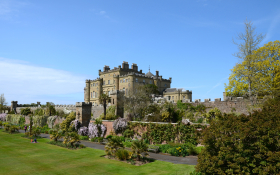
< Alloway Auld Kirk, the Brig O'Doon & Burns Monument
< Ayrshire - Overview
< Ayrshire #1
< Ayrshire #2
< Burns Cottage & Museum
< Coastal Drive
< Crossraguel Abbey
< Souter Johnnie's Cottage
Converted by Robert Adam to include a ‘Roman’ viaduct and Ruined Arch to add drama to this Italianate castle in its spectacular clifftop setting. It contains a fine collection of paintings and furniture, and a display of weapons in the Armoury. The Circular Saloon has a superb panoramic view over the Firth of Clyde and the beautiful Oval Staircase is Robert Adam’s final masterpiece of interior design. In 1945 the top floor was given to General Eisenhower as a token of Scotland’s recognition of his role during World War II. The Georgian Kitchen gives a glimpse of life below stairs 200 years ago. Country Park - Miles ofwoodland walks take the visitor to the Deer Park, along the Cliff Walkor to the many restored estate buildings, such as the Ruined Arch and Viaduct, beautiful Camellia House and unique Pagoda. Garden areas include the terraced Fountain Court and the Walled Garden with its redesigned pleasure garden and impressive reconstructed Victorian Vinery.
Just minutes from Burns Cottage lies the Auld Kirk, the setting for the enormously popular poem Tam O'Shanter. It was here Tam saw the witches and warlocks in devilish dance. The Kirkyard also contains the grave of William Burnes, the poet's father. The Bridge Spans the River Doon and was made famous as the setting for Tam O'Shanter's mare, Meg, losing her tail to witch Nannie. Cross the bridge for a good view of the 1823 Grecian Monument dedicated to the poet. In the grounds are Attractive gardens by the River Doon. The Bridge O’Doon Hotel is a great place to stop for a drink or lunch.
Home to the very first Open Golf Championship which was played at Prestwick, the coast is famous for its many links courses including the other Open Championship venues of Royal Troon and Turnberry. It's also the birth place of Scotland's most famous poet, Robert Burns. It is steeped in the history of Scottish kings and heroes, like Robert the Bruce and, so legend has it, of William Wallace. Playing a key role in Scottish history, it has castles and monuments dating back centuries and a wide range of visitor attractions.
Enjoy a visit to Burns National Heritage Park in Alloway. A collection of Burns-related sites including, Burns Cottage, where Scotland’s National poet was born. Continue on the scenic coastal route along the Heads of Ayr, passing the ruins of Dunure Castle and through “Electric Brae” to Culzean Castle. Perched high above the Firth of Clyde, this is considered one of Scotland’s’ most romantic castles with magnificent gardens.
Visit the City of Glasgow and the Burrell Collection. A world famous collection gifted to Glasgow by Sir William Burrell where visitors can see Tapestries, furniture, textiles, ceramics, stained glass and sculptures from medieval Europe, as well as art objects from Iraq, Egypt, Greece and Italy.
Burns Cottage was built in 1757 by the hands of Robert Burns' father. On January 25, 1759, while the cold winter winds blew in from the Atlantic, it became the scene of Scotland's most famous birthday when Robert Burns was born. The simple Auld Clay Biggin where the World's most loved poet was born has long been a must-see destination. An original manuscript of Auld Lang Syne takes pride of place in the most important collection of Robert Burns manuscripts, artefacts and memorabilia. Personal items, letters and artworks provide a unique touchstone to the life and work of a remarkable man.
While exploring Ayrshire be sure to travel along the coastal route (A719) between Turnberry and Alloway. The route will pass Culzean Castle, then through “Electric Brae” where your car will mysteriously freewheel uphill!. All the time the route affords wonderful views over the Forth of Clyde to the Island of Arran and beyond to the Mull of Kintyre. Continue past the ruins of Dunure Castle, where in what became known as The Black Vault, the 4th Earl of Cassilis had the Commendator of Crossraguel Abbey, Alan Stewart 'roasted in sop' until he signed over the Abbey lands. The Earl was later fined and instructed to pay Alan Stewart a pension, but he got to keep the lands. The route continues along the clifftops known as the Heads of Ayr to Alloway.
- Founded, sometime after 1244 when Bishop William of Glasgow commanded that a Cluniac monastery should be built there. 1286 was when the first abbot was recorded. Much of the original church had to be rebuilt after being badly damaged during the war with England in the early 1300s when the abbey had stayed loyal to the local man Robert Bruce. The tower house and gatehouse were built in the sixteenth century. Later in the sixteenth century, the abbey seems to have survived relatively unscathed through the Reformation when many other monasteries were severely damaged or destroyed.
In the small village of Kirkoswald (on the road to Turnberry) lies the home of John Davidson, village souter (shoemaker). He was the inspiration for the character Souter Johnnie, Tam's 'ancient, trusty, drouthy crony' in Burns' poem Tam O'Shanter. Life-sized stone figures of the Souter, Tam, the innkeeper and his wife are refurbished, contains period furniture, Burns relics and a reconstructed souter's workshop.
< Dunrobin Castle & Gardens
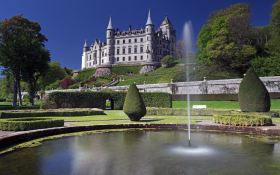
Sightseeing Suggestion: Dunrobin Castle is located a mile north of Golspie. Seat of the Earls and Dukes of Sutherland, this beautiful castle with a French influence sits looking out across the North Sea and is well worth a visit. With 189 rooms, it is the largest house in the Northern Highlands. Parts of it date back to the 1300s. There are many collections of furniture, pictures, objets d'art, uniforms, china and family memorabilia on display in the Drawing Room, Library, study, bedrooms, nurseries, etc. Visitors to the castle can also see a 19th century horsedrawn fire engine in the Sub Hall and look at the museum which is housed in the old summer house.
< Highlands #2
< Loch Ness & Urquhart Castle
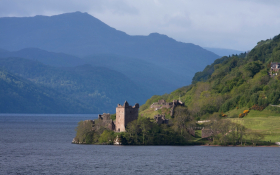
< Cawdor Castle
< Culloden Moor
< Dornoch - Overview
< Dornoch Cathedral
< Dornoch Jail & Gift Shop
< Falls of Shin
< Glen Ord Distillery
< Glenmorangie Distillery
< Highlands #1
< Highlands #3
< Huntly Castle
< Johnstons Cashmere Centre
< Nairn - Overview
< Ben Nevis
< Route Fort William to Turnberry
< Highlands #4
Sightseeing Suggestion: The Isle of Skye is one of the most visited regions of Scotland, boasting stunning views, a rich heritage, an array of wildlife, world-class dining, exciting adventures, and so much more. The crystal-clear waters of the enchanting Fairy Pools at the foot of the Black Cuillin Mountains really need to be seen to be believed with some visitors brave enough to take the plunge in the bracing waters. Also make time to visit Dunvegan Castle & Gardens, home of the Clan MacLeod for 800 years. There are many historical artifacts and fine paintings on show, none more so perhaps than the Fairy Flag – a sacred banner with astonishing powers that, when unfurled in battle, the clan would unfailingly defeat their enemies. For wildlife lovers, all creatures great and small can be found on the island or lurking in the skies and waters surrounding. Whales and dolphins can be found in the Lochs whilst golden and sea eagles prowl the air. Talisker Distillery is essential for a ‘dram’ or a guided tour for the whisky lovers whilst restaurants on the island offer the best and freshest seafood.
Sightseeing Suggestion: Dunrobin Castle is located a mile north of Golspie. Seat of the Earls and Dukes of Sutherland, this beautiful castle with a French influence sits looking out across the North Sea and is well worth a visit. With 189 rooms, it is the largest house in the Northern Highlands. Parts of it date back to the 1300s. There are many collections of furniture, pictures, objets d'art, uniforms, china and family memorabilia on display in the Drawing Room, Library, study, bedrooms, nurseries, etc. Visitors to the castle can also see a 19th century horsedrawn fire engine in the Sub Hall and look at the museum which is housed in the old summer house.
Enjoy a walking tour of Inverness. A cosmopolitan mix of residents and visitors gives Inverness an atmosphere that is unique in the Highlands. Travel south along the western shores of Loch Ness. The Loch is deeper than the North Sea, reaching 970 feet at its deepest point. Enjoy views of Urquhart Castle, one of the largest Castles in Scotland, which has lain in ruins since it was blown up in 1692.
Loch Ness is a place of outstanding natural beauty, but the world wide fame of Loch Ness owes more to the legend of its famous occupant, the Loch Ness Monster - or 'Nessie' - than the breathtaking location of the loch itself. The loch cuts a great divide along what is called Glen Mor, or The Great Glen. It is over 700 feet deep, and the nearby surrounding hills rise by about the same amount. Castle Urquhart, once one of Scotland's biggest castles but now in ruins for more than 200 years. In spite of that, it is a very impressive ruin consisting of the wall, four turrets and the keep. It is a splendid spot to visit and to take a picnic. The position of the castle on Strone Point is dramatic and commands a wide view of Loch Ness.
A fairy tale castle that has been the home of the Thanes of Cawdor since 1370, romantically linked by Shakespeare and Macbeth. The medieval tower and drawbridge are still intact and the house contains a suberb collection tapestries, pictures, furniture, books and porcelain.
The evocative scene of the last major battle fought on mainland Britain. The final Jacobite uprising ended here on 16 April, 1746, when the army of Prince Charles Edward Stuart was crushed by the Government forces, led by the Duke of Cumberland. You can relive the drama of Culloden at Living History presentations in the original Leanach Cottage, which survived the battle being fought around it, and has been restored. Also there are the Graves of the Clans, the Well of the Dead, the Memorial Cairn, the Cumberland Stone and the Field of the English. The Visitor Centre houses a permanent Jacobite exhibition, including an 18th-century sampler commemorating the battle and a historical display.
The Royal Burgh of Dornoch is an historic small town on the edge of the Dornoch Firth, a designated National Scenic Area in the Highlands of Scotland. Its tranquil location, scenery and climate have attracted visitors for decades. Some come to test their golfing skills on Royal Dornoch's championship course, or to walk and view wildlife in the National Nature Reserve at nearby Loch Fleet. Once the spiritual and administrative capital of Sutherland, Dornoch remains a thriving community today. Small in population (under 2500) but large in hospitality, Dornoch offers visitors a wide range of shops and businesses, two golf courses and an award-winning sandy beach. Its fine buildings include the 13th century cathedral, a bishop's palace (now a hotel), courthouse and old town jail.
Located in the centre of Dornoch, the cathedral was built around 1225 by Gilbert de Moravia, the Bishop of Caithness, who became St. Gilbert. Often uncared for, the cathedral has been subject to several restorations over the years. Today, the medieval core of the cathedral remains intact and it features fine stained glass from the late 19th and 20th Century There is also a memorial to philanthropist Andrew Carnegie (1835 - 1918), who lived nearby at Skibo Castle. In 2000, the cathedral hit the headlines as the location for the christening of Rocco, son of Madonna and her partner, English film-maker Guy Richie.
Dornoch’s 19th century town jail has been transformed into a contemporary designed shop, with unique Scottish products as well as a highland art gallery.
Set in the Achany Glen, amongst Highland scenery, Falls of Shin is perfect for those who enjoy the outdoors and wildlife. There are extensive forest walks, dramatic waterfalls and the famous salmon leap, where you can watch salmon hurl themselves up the falls, attempting to return to their place of birth to spawn. The visitor centre shop has a range of exclusive luxury Harrods gifts from Harrods Knightsbridge in London and superb quality local quality crafts, plus fresh local produce. Complete your day by enjoying home- made food and snacks served daily from noon in the restaurant
A visit to Glen Ord, on the edge of the Black Isle in the Highlands west of Inverness, is a delight to both the eye and the palate. Watch distillers at work creating a magicial malt whisky which is sweet, malty and dry on the palate.
Glenmorangie is said to mean The Glen of Tranquility. What is beyond debate is the growing contribution the distillery makes to the enjoyment of discerning whisky enthusiasts worldwide. And, in particular, in its native land, for Glenmorangie is the most popular single malt sold in Scotland itself. The distillery can be found a mile or so west of Tain just off the A9 close to where it crosses the Dornoch Firth on its way north from Inverness to Wick and Thurso. The local production of spirits goes back until at least the early 1700s when a still was recorded at the nearby Morangie Farm. The existing Distillery, however, had its origins as a brewery; before being converted to a legal still in 1843. Most of the existing buildings date from 1887.
Visit Glenmorangie Distillery, overlooking the shores of the Dornoch Firth. The name Glenmorangie comes from the Gaelic language and means “Glen of Tranquillity”. Continue to the town of Dornoch. Dignified and sleepy best describe this wonderful little town, clustered around its little Cathedral all in local stone. There are several charming antique shops and gift stores to be found in the town.
Visit Culloden Moor, the site of the Battle of Culloden, where in 1746, the repercussions of the defeat of the Jacobite Army by the English Troops changed the very nature of life in the Highlands of Scotland.
Huntly Castle is also known as Strathbogie Castle. Only remains of the Renaissance palace, built between 1597 and 1602, are all that stands now on the bank of the River Deveron In the 16th century it was renamed Huntly. The remains of a 12th century motte and bailey, an L-plan tower house, and defence earthworks of the Civil War are still visible. The most striking features of this palace are the splendid heraldic doorway and the carved fireplaces.
Johnstons mill in Elgin, stands on the site where the company was first founded in 1797. It remains one of the few vertical mills still operating in Scotland and is the only British mill to transform cashmere from raw fibre to finished garment. Throughout its long history, Johnstons have specialised in working with cashmere and luxury fibres to create exciting new collections of knitwear, accessories, home furnishings and fine fabrics. The Visitor Centre at Newmill offers mill tours and the opportunity to browse through an elegant shop situated in the original mill buildings.
Nairn is an attractive seaside town of 11,000 people who enjoy a prime location on the Moray Firth coast just 16 miles east of Inverness. A popular holiday destination since the middle of the last century. Nairn is a centre of golfing excellence with two 18 hole championship courses, including the Nairn Golf Club which staged the Walker Cup in 1999. The town also boasts some of the top beaches in Scotland and cleanest bathing waters in Britain. The waters of the Moray Firth are home to one of only two dolphin colonies in the UK. These fascinating and playful creatures regularly visit Nairn and can be seen from several vantage points on the shore. Nairn is steeped in history and is closely linked with the Battle of Culloden, the final land battle on mainland Britain.
Sightseeing Suggestion: The Isle of Skye is one of the most visited regions of Scotland, boasting stunning views, a rich heritage, an array of wildlife, world-class dining, exciting adventures, and so much more. The crystal-clear waters of the enchanting Fairy Pools at the foot of the Black Cuillin Mountains really need to be seen to be believed with some visitors brave enough to take the plunge in the bracing waters. Also make time to visit Dunvegan Castle & Gardens, home of the Clan MacLeod for 800 years. There are many historical artifacts and fine paintings on show, none more so perhaps than the Fairy Flag – a sacred banner with astonishing powers that, when unfurled in battle, the clan would unfailingly defeat their enemies. For wildlife lovers, all creatures great and small can be found on the island or lurking in the skies and waters surrounding. Whales and dolphins can be found in the Lochs whilst golden and sea eagles prowl the air. Talisker Distillery is essential for a ‘dram’ or a guided tour for the whisky lovers whilst restaurants on the island offer the best and freshest seafood.
< Edinburgh Castle
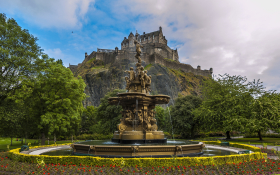
< Edinburgh - Overview

< East Lothian #1

< Royal Mile
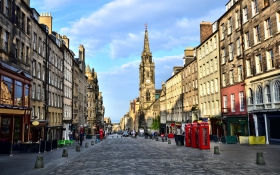
< East Lothian - General
< East Lothian #2
< Edinburgh Military Tattoo
< Glenkinchie Distillery
< Holyrood Palace
< John Muir House
< Lennoxlove
< National Museum of Scotland
< Royal Botanic Garden Edinburgh
< Royal Yacht Britannia
< Scottish Seabird Centre
< Shopping
< Tantallon Castle
Edinburgh Castle has stood guard high over the city since 1085. One of the city's most distinctive and most visited landmarks, Edinburgh castle is perched high up in the city centre on the craggy remains of an extinct volcano. It was also the site of an Iron Age fort. Among its attractions are the Great Hall, a great siege gun, Mons Meg, and the tiny room where Mary Queen of Scots gave birth to James VI of Scotland and I of England.
Scotland’s capital city is famous for it’s history, architecture, festivals, friendly people, and city walking. The city is divided between the Old Town and the New Town. The Old Town is where you will find the vast amount of ancient buildings whilst the New Town is more a celebration of business, order and classical Georgian architecture. This is the terrain of the shops, offices and banks as well as many bars and cafes. The dock area of Leith to the north of the city centre is also an upcoming area that has seen much development in recent years. A great way to get a good feel for the city is to take one of the Open Top Bus City Tours. The majority of these tours leave from Waverley Station and allow you to hop on and off as you wish at each stop.
Enjoy a visit to Edinburgh, the nation’s capital and one of the finest cities in the world. The Old town packs more historic buildings into one square mile than any other city in Britain. The Royal Mile winds it way from the Palace of Holyroodhouse to Edinburgh Castle, which of course dominates the city and is Scotland’s most popular attraction. Do not miss the New town, full of fine architecture, sweeping cresents, squares and circles where gardens are an integral part.
The walk takes you in a straight line from Edinburgh Castle all the way down the hill to the Palace of Holyroodhouse, passing the major sights of St Giles Kirk and Parliament House, and on to Arthur's Seat in Holyrood Park. The main street, is crowded with 'lands' (or tenements) many storeys high, and punctuated by tiny cobbled 'closes' or alleys off to each side
East Lothian is full of charming towns and villages inviting you to browse in art galleries, museums and gift shops while you can also discover much of Scotland's history in the region's castles, churches and country houses. Visit North Berwick, a smart seaside resort with attractive beaches, a picture postcard harbour and the award-winning Scottish Seabird Centre.
Visit the East Lothian coastline, a mix of sandy seashores and picturesque little villages. Dirleton Castle dates back to the 12th century. The Royal Burgh of North Berwick overlooks the Bass Rock, with its huge range of seabirds and Tantallon Castle, an imposing 14th century castle ruin sits overlooking the Firth of Forth.
Takes place each year during the festival in August. The show contains performances by Massed Military Bands and the world-famous Massed Pipes & Drums, Massed Highland Dancers, the haunting sound of the Lone Piper, and acts from across the globe, including India, South Africa, New Zealand and the Far East played in the unique setting of historic Edinburgh Castle.
A visit to Glenkinchie, home of Edinburgh Malt involves a pleasant into the rolling farmland of East Lothian. Here you can see the distillers at work employing the excellent Scottish barley and pure clear water from the nearby Lammermuir Hills in the making of a capital malt in every respect. An exhibition of malt whisky is housed in the listed red brick buildings and the dram in the distillery bar usually satisfies any further thirst for knowledge.
Founded as a monastery in 1128, the Palace of Holyroodhouse in Edinburgh is The Queen's official residence in Scotland. Situated at the end of the Royal Mile, the Palace of Holyroodhouse is closely associated with Scotland's turbulent past, including Mary, Queen of Scots, who lived here between 1561 and 1567.
John Muir's life and work has inspired people all over the world. Now the Dunbar birthplace of the pioneering conservationist has been transformed into a new visitor attraction. The stunning interpretative centre highlights the work and achievements of this remarkable man. Born in Dunbar in 1838, John Muir emigrated with his parents to the United States where he campaigned for the preservation of natural environments through his work as an environmentalist, geologist and botanist.
Dating from the 14th Century, is the home of the Duke of Hamilton, Scotland's premier Duke, and is situated in 600 acres just 25 minutes drive south east of Edinburgh. Originally built in the 14th century for the Maitlands of Lethington, the house was named Lennoxlove after Frances Teresa Stewart, Duchess of Richmond and Lennox, a renowned beauty and favourite of Charles II. Lennoxlove was acquired by the 14th Duke of Hamilton in 1946 and remains a splendid setting for the famous Hamilton Palace collection of furniture and paintings as well as mementoes of Mary Queen of Scots. Only open on certain days of the week for public viewing.
The museum of Scotland, completed in November 1998, is a fine example of traditional and modern architecture working in harmony. Inside the displays are fascinating and beautifully presented, with interactivity and evocative exhibits (oldest locomotive engine, Roman treasure, a Viking skeleton, and more) adding to the experience.
This verdant oasis in Edinburgh's New Town area and Scotland's answer to Kew gardens is not only a place to learn about exotic flora, but its lush surroundings make it the perfect place to wile away a sunny afternoon.
Located in Leith. For over forty years Britannia served the Royal Family, travelling over one million miles. They offer a self led audio tour of four decks of the ship and a visitor centre.
An award winning wildlife visitor centre and one of Scotland's five star attractions. From its stunning location overlooking the sea and islands of the Forth, visitors enjoy a close encounter with nature to remember. The ultimate in remote viewing, cameras on the islands beam back live panoramas and close-ups onto giant screens of such good quality that visitors can even read the rings on individual birds' feet. New this year are boat safaris to the islands, with experienced guides on board.
Edinburgh has a wide variety of shopping from the largers stores along Princes St where best buys are Scottish crystal, tartans, woolens, antiques and the omnipresent shortbread biscuits. This historic street is worth a visit. The Old Town provides a huge variety of shops catering for every taste. from whisky to the occult and from Highland Dress to Playing Cards. There are Galleries, Antique Shops, Crafts, Jewelry, Textiles, Cameras and Electrical Goods. You will find hostelries whose history goes back for centuries next door to the most cosmopolitan of restaurants. Whatever your taste, you will find somewhere to enjoy eating and drinking in the Old Town. And it isn't all in the Royal Mile, for some of the most intriguing shops, the most enjoyable food and drink, you must explore the Grassmarket and the Bridges and look down the interesting side streets and closes.
A formidable stronghold set atop cliffs on the Firth of Forth, Tantallon Castle was the seat of the Douglas Earls of Angus, one of the most powerful baronial families in Scotland. In the late 14th century, they built a great stone curtain across a rocky promontory overlooking the Bass Rock. Its lofty towers and halls provided an imposing residence befitting a feudal lord and his household and suitably strong defences. Tantallon served as a noble fortification for more than three centuries and endured frequent sieges. During Cromwell's invasion in 1651 it suffered heavy damage and its days as one of the country's mightiest castles came to a close.
< Glamis Castle
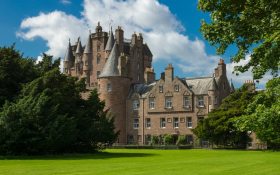
< St Andrews Cathedral
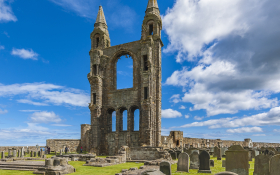
< St Andrews - Overview
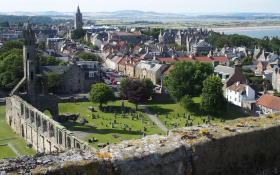
< Stirling Castle
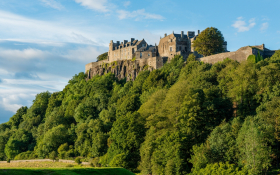
< Arbroath Abbey
< Bannockburn Heritage Centre
< Broughty Ferry
< Carnoustie - Overview
< Carnoustie #1
< Carnoustie #2
< Discovery Point
< Falkland Palace
< Fife Coastal Path
< Gleneagles - Overview
< Gleneagles #1
< Gleneagles #2
< Glenturret Distillery
< House of Dun
< Kellie Castle & Gardens
< Local Coastal Villages
< Scone Palace
< Scone Palace
< Scottish Fisheries Museum, Anstruther
< St Andrews #1
< St Andrews #2
< St Andrews Castle
< St Andrews Shopping
< The Trossachs
< Wallace Monument
< The 147th Open at Carnoustie
The family home of the Earls of Strathmore and Kinghorne and has been a royal residence since 1372. It was the childhood home of HM Queen Elizabeth The Queen Mother, the birthplace of Her Royal Highness The Princess Margaret and the legendary setting of Shakespeare's play "Macbeth". Though the Castle is open to visitors it remains a family home, lived in and loved by the Strathmore family. It has Magnificent rooms on view with a wide range of historic paintings, furniture, porcelain and tapestries. (1 hour drive from St.Andrews)
Enjoy the dramatic setting of the ruins. The Cathedral was destroyed by a mob roused by the preaching of John Knox in the town during the Reformation - and the sense of history which attaches to what was once one of the most important religious sites in Europe. Owing to the presence of the relics of St Andrew, it was a place of pilgrimage for many thousands during the medieval period. The view from the top of St Rule's Tower is breathtaking, and the visitor centre contains a number of artifacts and helps to set the history of the site into context. Golfers can pay a visit to the grave of Old Tom Morris and his son young Tom, who are buried in the Cathedral Grounds.
St Andrews has a special place in Scottish history and legend. It takes its name from the saint whose relics were brought to the town. It played a important role in Scotland’s affairs, its cathedral was the largest building in Scotland and the centre of the country’s religious life. It has the oldest University in Scotland (where Prince William is currently studying) and of course has been a pilgrimage to golfers wishing to play on the Links where golf was first played. The historic town is easily and best explored on foot where the shops, many interesting buildings, museums, bars and restaurants are all easily accessible.
Perched high on a volcanic outcrop, it played a major part in the Scottish struggle against English domination. Time and time again, it was besieged once again; involving, amongst others, great names like William Wallace and Robert the Bruce. It was here too that James II murdered the Earl of Douglas and had his body tossed from a window, and the castle was also the childhood home of the ill-fated Mary Queen of Scots. Architecturally, it offers an array of riches: the vast Great Hall dating from the end of the Middle Ages, the early Renaissance splendours of the Palace with its carved heads, and the Chapel Royal built for the baptism of Prince Henry in 1594. New interpretive displays and a new restaurant with four specially-designed hangings have added to the enjoyment of visiting this, the grandest of Scottish castles.
Arbroath Abbey is situated in the centre of Arbroath. Founded in 1178 by William the Lion and dedicated to St Thomas of Canterbury, it was from here that the famous Declaration of Arbroath, asserting Scottish Independences, was issued in 1320. Important remains of the church survive; these include one of the most complete examples of an abbot's residence.
Situated at one of the most important historic sites in Scotland. On the battlefield nearby, in June 1314, King Robert the Bruce routed the forces of King Edward II to win freedom for the Scots from English domination. A few yards from the Centre is the famous Boresone site which by tradition was Bruce’s command post before the battle. The site is enclosed by the Rotunda focusing on the approach route of the English army to its objective – Stirling Castle. The Centre provides an exhibition – The Kingdom of the Scots with an audio-visual presentation of the Battle of Bannockburn; display panels at Rotunda.
Between Carnoustie and Dundee is the delightful seaside suburb of Broughty Ferry . Once the “richest square mile in Europe”, this was where the wealthy jute barons of Dundee built their mansions. The town was originally a cluster of fisherman’s cottages around the harbour which is overlooked by Broughty Castle. Today the castle is a fascinating museum.
Carnoustie has long held a reputation throughout the world as one of the great golfing locations. Ever since the British Open was first played at Carnoustie in 1931, the course has represented a magnetic challenge for golfers of all standards. The Open Championship has been contested over the Carnoustie course on five previous occasions. The return of the championship in 1999 brought an end to the Open's twenty-four year absence from the Carnoustie Links. Carnoustie has for many years been a popular holiday town with views across the Tay estuary to the Kingdom of Fife. Fetes and special events are featured throughout the summer, with Carnoustie Gala week being the high point.
Enjoy a visit to Glamis Castle, childhood home of Queen Elizabeth, The Queen Mother, and birthplace of Princess Margaret. The family home of the Earls of Strathmore and Kinghorne it has been a Royal residence since 1372 and is the legendary setting of Shakespeare’s play Macbeth.
Visit Discovery Point in Dundee, an attraction centred on Captain Scott’s famous polar exhibition ship which was built in Dundee at the turn of the century to take Scott to the ends of the earth. Then to the Verdant works, a restored 19th century jute works surrounding a cobbled courtyard, where you will discover why Dundee became jute capital of the world.
Follow in the footsteps of Captain Scott and Ernest Shackleton to the South Pole at Discovery Point, the award-winning attraction and museum that tells the story of the RRS Discovery. The exhibitions are a mix of state of the art audio-visual and computer based multimedia, alongside displays of actual artefacts that belonged to Scott and the brave crew who sailed with him.
Falkland has been a royal palace since the days of the Stewarts. King James IV completed the main structure and King James V also added to the buildings there, transforming it into a sophisticated Renaissance palace. He was also responsible for adding the royal tennis court in 1539, which has survived to this day. James V died at Falkland Palace on December 14, 1542. His daughter, Mary Queen of Scots was a frequent visitor, enjoying the peace and tranquility of Falkland, away from the intrigues and politics of Edinburgh.
You may enjoy walking a stretch of the Fife Coastal Path from Crail to St.Monans. Visit the many picturesque towns with their narrow cobbled lanes leading to picturesque harbors.
The Gleneagles Hotel lies in the heart of the Perthshire Countryside. The resort has a wonderful range of on site activities, sports and outdoor pursuits to keep you entertained throughout your stay. It’s central location makes an ideal base for touring around many parts of Scotland. The following is an example of local attractions, however it is not unreasonable to travel to St.Andrews, Edinburgh and even the the scenic West Coast of Scotland if you are prepared for a full day of touring.
Travel to Crieff for a visit to the Glenturret Distillery; established in 1775 the distillery is the oldest Highland malt distillery in Scotland. Travel west from Crieff along the shores of Loch Earn enjoying the scenery through the Queen Elizabeth Forest Park to Callander. This is Rob Roy Country and a visit to the Trossachs Visitor Centre relates the full story as he roamed the hills around Callander.
Enjoy a visit to Stirling, the ancient capital of Scotland that lies at the heart of the nation’s history. The streets of the Old town all wind upward towards the castle, 250 feet up on its craggy rock dominating the surrounding landscape. Considered by many as Scotland’s grandest castle. The castle architecture is outstanding with the Great Hall and Chapel Royal among the highlights.
Scotland's oldest distillery lies in a picturesque setting just outside Crieff in the heart of Perthshire. The award-winning visitor centre has welcomed over 2,000,000 visitors since opening in 1981 and offers facilities of the highest quality. Come and discover Glenturret at its source and enjoy a 'dram' and some good food at one of Scotland's top visitor attractions.
This Georgian house overlooking the Montrose Basin, designed and built by William Adam in 1730 for David Erskine, Lord Dun. Superb contemporary plasterwork by Joseph Enzer. Lady Augusta Kennedy-Erskine was the daughter of William IV and Mrs Jordan, and the house contains royal mementos of that period and many examples of Lady Augusta’s woolwork and embroidery. Family collection of portraits, furniture and porcelain.
Located near Anstruther a 20mins drive from St.Andrews, it contains magnificent plaster ceilings, painted panelling and furniture. The Gardens contain a fine layout of the organic walled garden is 17th-century with late Victorian additions and contains a fine collection of old-fashioned roses, fruit trees and herbaceous plants. Display in summer-house on history of walled garden.
Visit the quaint coastal fishing villages and Royal Burgh’s of Crail, Anstruther and Pittenweem with their distinctive buildings and picturesque harbours. The area was notorious for smuggling with wine, tobacco, cloth and sugar being smuggled in, and linen and coal smuggled out. The East Neuk was the capital of the Scottish Herring industry, until the shoals deserted the Forth during the Second World War. Today the boats which sail out from Crail and Anstruther mainly bring in shellfish, while Pittenweem remains the centre of the areas fishing industry where early in the morning the catches are sold at the new Fish Market.
Only 30 minutes from Dundee, Scone Palace is the one-time crowning place of Scottish Kings, and home of the Earls of Mansfield. Palace, magnificent collections of objets d'art, hundred acres of garden with woodland walks, shops, restaurants, unique Murray Star maze and pinetum.
Only 30 minutes from Gleneagles, Scone Palace is the one-time crowning place of Scottish Kings, and home of the Earls of Mansfield. Palace, magnifcent collections of objets d'art, hundred acres of garden with woodland walks, shops, restaurants, unique Murray Star maze and pinetum.
This award-winning National Museum tells the story of the Scottish fishing industry from the earliest times to the present. With many model and actual boats, fishing gear, photographs, paintings and tableaux on display, as well as a new 'Zulu' gallery just open, a visit to the Museum makes for worthwhile visit.
Enjoy time in St.Andrews, one of the most Historic Towns of Scotland. Hallowed in the hearts of golfers the world over, St. Andrews is also a centre of Secular, Spiritual and Academic life. Take a stroll through the Cathedral grounds, once the resting place of Scotland's patron saint and after whom the town is named, and pass the castle where the Bishops lived when St Andrews was the Ecclesiastical capital of the country. The town is the perfect place to gift shop with hundreds of stores and boutiques, each with its own character and charm.
Tour the coastline of the East Neuk of Fife and visit the many quaint fishing villages with their distinctive buildings and picturesque harbours. Crail, Anstruther and Pittenweem are to be found in close proximity to St.Andrews, while Anstruther houses the Scottish Fisheries Museum. Some of the best fish and chips in Scotland can be found here.
The Castle was the former Bishops' Palace, the residence of the Archbishops of St Andrews. The first castle on this site probably dates from around 1200. Over the centuries, the Castle has witnessed many conflicts and deeds of infamy, among them the martyrdom of George Wishart and the murder of Cardinal Beaton. It was also besieged many times. Eventually destroyed during the Reformation, the Castle is now in ruins. A modern visitor centre houses exhibits about the Castle, and visitors can also explore the mines and the infamous bottle dungeon.
St Andrews is a town to explore and is refreshingly free of national outlets and chain stores. Instead, the town centre offers an excellent range of independent, family-run shops and businesses, where you are guaranteed to find a unique range of goods matched by personal service. Shopping in St Andrews is always a rewarding experience. The main shopping areas concentrated in Market Street and South Street, with Bell Street and Church Street connecting the two principal streets. There are Golf Stores throughout the town with the main stores of Auchterlonies, Old Tom Morris and Golf Scotland all located close to the 18th Green of the Old Course.
Departing from Gleneagles travel north west to Crieff (Glenturret Distillery) take the A85 along the shores of Loch Earn enjoying the scenery along the way. From Lochearnhead a slight detour to Killin and Loch Tay can be taken (Falls of Dochart, Breadalbane Folklore Centre). Otherwise continue from Lochearnhead south on A84 coming off this road for a visit to Rob Roy’s Grave. Continue through the Queen Elizabeth Forest Park to Callender, Rob Roy & Trossachs Visitor Centre, Hamilton Toy Museum, Kilmahog Woollen Mill. From Callender follow the signposted Trossachs Trail either clockwise or anti-clockwise, visiting Aberfoyle for the Scottish Wool Centre, Queen Elizabeth Forest Park Visitor Centre, Lake of Menteith & Inchmaholm Priory and back to Callander. Return to Gleneagles along the A84 through Doune and rejoining the A9 north of Stirling.
Completed in 1869 after eight years' construction, the 220 feet high Wallace Monument sits prominently on the Abbey Craig two miles north of the city of Stirling itself. It was from this prominent hilltop in 1297 that William Wallace watched the English army approach across Stirling Bridge before leading the Scots into the battle of the same name and victory. A fitting, and striking, location for the national monument to a national hero. Be sure to climb the monument to view what is said to be the 700 year old Wallace sword, some 5 feet 4 inches long. Coming face to face with such a magnificent piece of metalwork you wonder how anyone could have lifted or carried it, still less fought with it.
< Inveraray
< Inveraray Castle
< Loch Lomond - General
< Loch Lomond #1
< Loch Lomond Shores
< Luss
< Machrihanish #1
< The Hill House
Take a scenic drive along the shores of Loch Fyne to Inveraray. The town enjoys a picturesque setting where Loch Fyne meets Loch Shira. It was built on the site of an earlier fishing village in the mid 1700s by the 3rd Duke of Argyll, chief of the powerful Clan Campbell. He demolished the old village to build a grand castle and rehoused the population in attractive Georgian houses on a new Main Street.
The present Castle, home to the Duke of Arygll and was built in the third quarter of the 18th century by Roger Morris and Robert Mylne. The Great Hall and Armoury, the State Rooms, tapestries, pictures and 18th century furniture and old kitchen are all on show. Take time to explore the village of Inveraray, the Jail, Maritime Museum and the Bell Tower. A good recommendation for a lunch stop would be the renowned Loch Fyne Oyster Bar, which serves top quality local fish and shellfish in relaxed surroundings.
Set amidst one of Scotland’s most idyllic and unspoilt areas with the largest expanse of fresh water in Britain and the backdrop of the mountains looming beyond. Loch Lomond has long been immortalised in lyric verse and song. The single biggest expanse of inland water in the British Isles, Loch Lomond brings together two very different Scotlands. Broad, island-dotted shallows in the south gradually narrowing and steepening into the mountains of the aptly named “Arrochar Alps” dominated by the Cobbler in the West and mighty Ben Lomond to the East. The historic town of Stirling, the cosmopolitan City of Glasgow and the scenic West Coast of Scotland are all easily accessible.
Tour along the western shores of Loch Lomond. Stop at the picturesque village of Luss, before continuing towards Arrochar. The surrounding mountains signify where the rugged Highlands take over from the rolling hills of the south. Continue to Inveraray, located on the shores of Loch Fyne. A tour of Inveraray Castle is recommended, seat of the Duke of Argyll and erected between 1745-1790. Other attractions in the town include the Jail, Maritime Museum, Bell Tower and Woollen Mill.
A magnificent state-of-the-art purpose-built visitor centre which offers a unique opportunity to appreciate the natural environment. Through films, exhibits and boat trips, this is an entertaining way to hear about the fascinating history, legends and natural heritage of the loch and surrounding landscape. There is a range of shops, including the famous Edinburgh stores, Jenners - cafes, restaurants as well as woodland walks and bicycle rides through the Loch Lomond and The Trossachs National Park right beside the loch.
Enjoy a visit to the village of Luss just minutes from Loch Lomond Golf Club. One of the prettiest villages in Britain. The heart of the village is a street flanked by lovely cottages running down to the shore of Loch Lomond and Luss Pier, from where pleasure trips can be taken in Summer. Just to the south of the centre of the village, and still overlooking the Loch, is Luss Church, built by the Colquhouns in 1875. This is a really nice little church with a fascinating graveyard. The church interior is especially worth exploring.
Tour the Kintyre Peninsula. This gentle corner of the Highlands affords wonderful views over to the Atlantic Ocean and out to the Islands of Gigha, Islay and Jura. Visit the charming fishing village of Tarbert on the shores of Loch Fyne, and then continue around the peninsula returning down the eastern shores with wonderful views over to the Isle of Arran. The coast road takes you to Claonaig, for views of Skipness Castle, stopping at Carradale and Saddell Abbey.
The finest of Charles Rennie Mackintosh¿s domestic creations, The Hill House sits high above the Clyde in the town of Helensburgh, commanding fine views over the river estuary. Walter Blackie, director of the well-known Glasgow publishers, commissioned not only the house and garden but much of the furniture and all the interior fittings and decorative schemes. Mackintosh¿s wife, Margaret MacDonald, contributed fabric designs and a unique gesso overmantel. The overall effect is daring, but restrained in its elegance: the result, timeless rooms, as modern today as they must have been in 1904 when the Blackie family moved in. The gardens have been restored to their former glory, and reflect features common to Mackintosh’s architectural designs.
Scotland Central
Blairgowrie Golf Club ~ Blairgowrie - RosemountCarnoustie Golf Links ~ Carnoustie
Crail Golfing Society ~ Crail - Balcomie Course
Dumbarnie Links ~ Dumbarnie Links
Fairmont St Andrews ~ Fairmont St Andrews - Kittocks Course
Fairmont St Andrews ~ Fairmont St Andrews - Torrance Course
Gleneagles Hotel ~ Gleneagles - King's Course
Gleneagles Hotel ~ Gleneagles - PGA Centenary Course
Kingsbarns Golf Links ~ Kingsbarns
Panmure Golf Club ~ Panmure
St Andrews Links Trust Commercial ~ St Andrews - Castle Course
St Andrews Links Trust Commercial ~ St Andrews - Jubilee Course
St Andrews Links Trust Commercial ~ St Andrews - New Course
St Andrews Links Trust Commercial ~ St Andrews - Old Course
Scotland East
Anstruther Golf Club ~ AnstrutherArcherfield Links ~ Dirleton Links
Archerfield Links ~ Fidra Links
Craigielaw Golf Club ~ Craigielaw
Dunbar Golf Club ~ Dunbar
Gullane Golf Club ~ Gullane No.1
Gullane Golf Club ~ Gullane No.2
Longniddry Golf Club ~ Longniddry
North Berwick ~ North Berwick
Renaissance Club ~ Renaissance
The Honourable Company of Edinburgh Golfers ~ Muirfield
Scotland North
Brora Golf Club ~ BroraCabot Highlands ~ Cabot Highlands - Castle Stuart
Cabot Highlands ~ Cabot Highlands - Old Petty
Fortrose & Rosemarkie Golf Club ~ Fortrose & Rosemarkie
Golspie Golf Club ~ Golspie
Moray Golf Club ~ Moray - Old Course
Nairn Golf Club ~ Nairn
Royal Dornoch Golf Club ~ Royal Dornoch
Tain Golf Club ~ Tain
Scotland West
Carradale Golf Club ~ CarradaleDundonald Links ~ Dundonald Links
Gailes Links ~ Gailes Links
Machrihanish Dunes ~ Machrihanish Dunes (Resident)
Machrihanish Golf Club ~ Machrihanish
Prestwick Golf Club ~ Prestwick
Royal Troon Golf Club ~ Royal Troon
The Machrie Links ~ The Machrie Links
Trump Turnberry ~ Trump Turnberry - Ailsa Course
Trump Turnberry ~ Trump Turnberry - King Robert the Bruce
Western Gailes Golf Club ~ Western Gailes







































